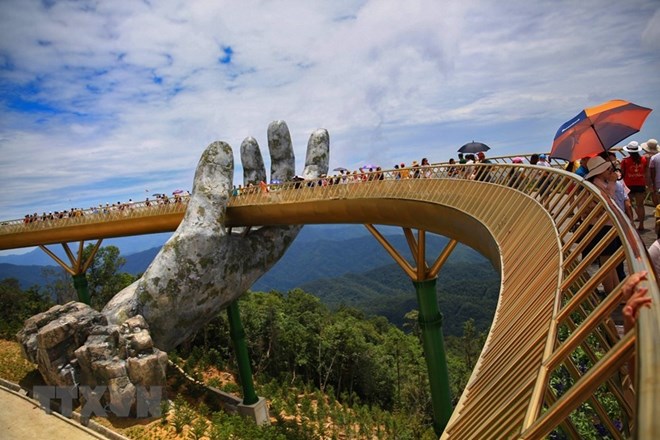


The central coastal city of Da Nang will increase the level of scrutiny applied to budget tours in a bid to further develop sustainable tourism services.

The Golden Bridge in Da Nang city (Photo: VNA)
Although low-cost tours or the so-called "zero dong” tours have
catered to an increasing number of tourists visiting the city in recent years,
there is a growing concern about their impact on the local economy. Customers
on such budget tours are forced to follow the agencies’ itinerary, often
visiting tourist attractions, restaurants and shopping malls where payments are
electronically transferred back to foreign countries, leaving little to no
profit for Da Nang city.
Beyond this, the demand for budget tours has sparked competition between travel
companies and service industry businesses, eager to capitalise on the city’s
popularity while avoiding paying taxes to local authorities.
According to Ngo Quang Vinh, Director of the municipal Department of Tourism,
the rise of budget tours is not unique to Da Nang and studies have shown their
impact on markets in neighbouring countries, such as Thailand and Cambodia.
Statistics showed that low-cost tours make up 30 percent of the total tourism
market in the region.
In a bid to reduce the number of cheap tour operators, Da Nang city is working
with relevant agencies to ensure that visitors make proper payments in line
with regulations. Enhancing inspections at local shops and restaurants has been
prioritised to detect fraudulent trade and tax evasion.
The city is now channeling its focus on improving standards for travel agents
while simultaneously working to ensure that shopping malls operate in
accordance with regulations. Plans are in motion to set up representative
offices in China and the Republic of Korea where greater scrutiny can be
applied to package tours sold there.
Meanwhile, sustainable tourism products will be monitored to ensure that they
continue to attract high-end tourists, generating higher revenues and benefits
for the local population.
Da Nang’s tourism sector has grown exponentially, with an average annual growth
of 20.06 percent between 2013 and 2017.
Last year alone, it hosted 6.6 million tourists, including 1.67 million
foreigners. From the outset of 2018, the city welcomed around 6.5 million
visitors, up 27.7 percent from the same period last year, of whom 2.4 million
were foreign travellers. Total revenue gained from the tourism sector was
estimated at 14 trillion VND (597 million USD), a year-on-year increase of 12.3
percent.
The city has bolstered its promotion of tourism in Thailand, Indonesia, Hong
Kong (China), Japan and the Republic of Korea, and expanded efforts in
Australia, Western Europe and Russia.
Da Nang city remains a popular tourist destination in central Vietnam and
continues to develop. The online marketplace and hospitality service Airbnb
announced listings of the world’s top 10 destinations for 2018, in which the
city ranked fifth with a 255 percent growth in bookings.
Source:VNA